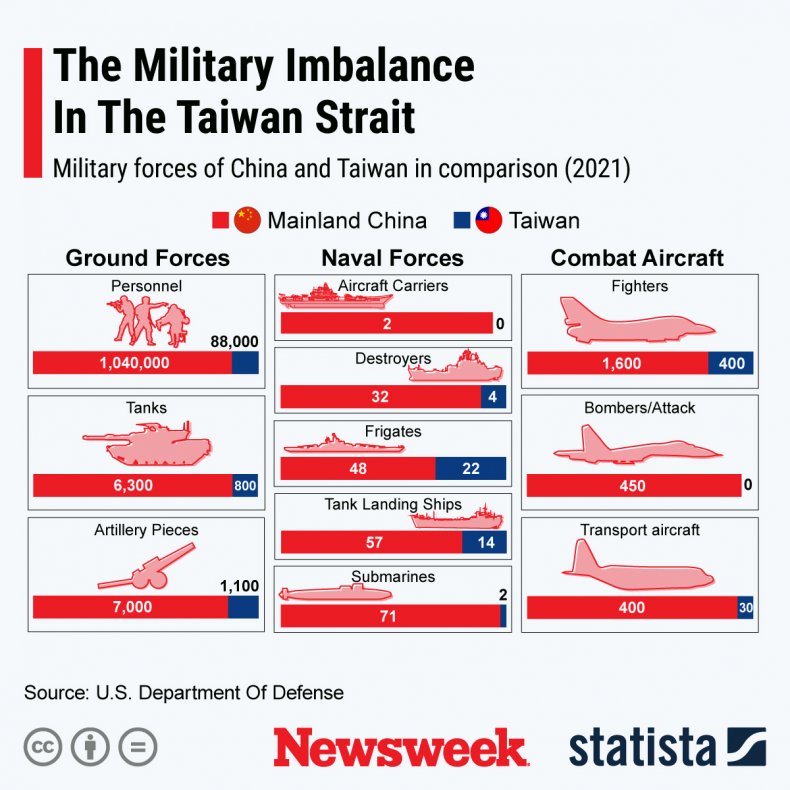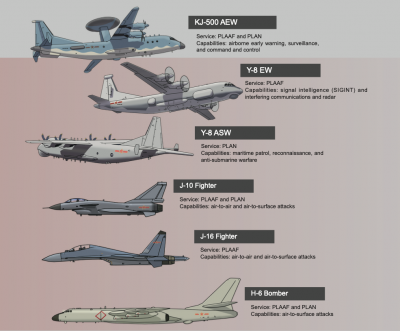JOHN FENG
China is continuing an expansive military buildup as part of a multifaceted campaign to frighten Taiwan into submission and capture the island without firing a single shot.
That was the assessment Taiwan provided on Tuesday in publishing its 2021 National Defense Report, a biennial government document that has been tracking the shifting power balance across the Taiwan Strait for the last three decades.
In a report that echoed many of the observations and concerns raised in Japan's own defense white paper in July, Taiwan described the People's Republic of China (PRC) as having ambitions that reach far beyond the so-called first island chain, the frontline of the American alliance system and its maritime deterrent.
In a foreword for the report, Taiwan Defense Minister Chiu Kuo-cheng said the democratic island was caught in the middle of the "strategic competition" taking place between the United States and the PRC, with the latter "leveraging its comprehensive national power to expand geopolitical influence."
Chiu, the country's former head of intelligence who was appointed defense chief in a February reshuffle, said Taiwan had demonstrated "unquestionable determination and ability" to defend itself, but for the first time openly noted the critical role that Taipei's allies could play in preventing a cross-strait conflict.
Chiu said only "a collective power" could keep peace in the region. "Therefore, it is hoped that regional partners and like-minded countries can jointly promote security cooperation and shoulder the responsibility to maintain a sustainable development in the region."
This Statista graph shows the military imbalance across the Taiwan Strait.
 The military imbalance in the Taiwan Strait.STATISTA
The military imbalance in the Taiwan Strait.STATISTAThe defense white paper said the PRC "has never renounced the option of the use of force against Taiwan"—a point regularly enforced by Chinese leader Xi Jinping himself as well as government spokespeople. The People's Liberation Army—the armed wing of China's ruling Communist Party—continues to conduct military exercises in preparation for an invasion, and for the purposes of threatening Taiwan, said the report.
Chief among Taiwan's most pressing defense concerns are activities that fall under the category of "gray zone," actions that harass, pressure and coerce, but ultimately fall short of war. The Defense Ministry document puts the PLA's routine air force operations near the island, its intensifying training exercises in the neighboring waters and the PRC's military intimidation at the top of the list.
"The gray zone threats frequently posed by the PRC on us are orchestrated generally through military and non-military approaches which have exploited the limbo between peace and war," the report said. "It attempts to consume our combat power and shake our faith and morale to ultimately achieve its goal of 'seizing Taiwan without a fight.'"

This illustration produced by Taiwan's Defense Ministry and published as part of its 2021 National Defense Report on November 9, 2021, shows the most frequent aircraft appearing in Taiwan's air defense identification zone in the last two years.MINISTRY OF NATIONAL DEFENSE, TAIWAN
The report, titled "Forging a Resilient and New Armed Forces," details the transformation of Taiwan's armed forces from a conventional military into one of which the sole purpose is to conduct "asymmetric warfare" against the PLA.
"Asymmetric warfare aims at attacking or capitalizing on the adversary's vulnerabilities and disrupting its operational center of gravity rather than attacking its principal strength," it explained. "By maximizing our asymmetric advantages, we can frustrate the enemy's desire for a quick endgame."
Defense planners have asked the government to earmark funds for specific types of weaponry that are small, accurate and highly maneuverable, and which have a greater chance of withstanding the PLA's attacks than larger, more expensive platforms.

An AH-1W SuperCobra assigned to Taiwan's Republic of China Army takes part in a live-fire exercise on April 15, 2021, in Pingtung, Taiwan.MILITARY NEWS AGENCY / MINISTRY OF NATIONAL DEFENSE, TAIWAN
"To achieve deterrence, Taiwan must demonstrate an effective ability to target PLA vulnerabilities in ways that can overcome the PLA's advantages. The PLA's weakness is in the phase of sea transit. The Armed Forces must take full advantage of the natural barrier of the Taiwan Strait and fight in a resilient manner," the report said.
"We should not limit ourselves to waiting for the enemy's landing groups to sail through the Strait, but should also use measures to force the enemy to assemble forces at airfields or ports further away from areas opposite Taiwan," it added.
It concluded: "Given the likely enemy course of action, an asymmetric strategy should be based on dissimilar responses to PLA capabilities. For example: countering hostile fixed-wing aircraft or airborne operations with mobile surface-to-air missiles; countering large surface ships with small, fast, mobile, and seaworthy resilient platforms, and, in wartime, incorporating Coast Guard assets equipped with anti-ship missiles; and countering the enemy's triphibious landing operations with mobile coastal defense cruise missiles, defensive naval mines, and landmines."
Taiwan's defense report notes that the Chinese military is already capable of isolating the island during an armed conflict. "At present, the PLA is capable of performing local joint blockade against our critical harbors, airports, and outbound flight routes, to cut off our air and sea lines of communication and impact the flow of our military supplies and logistic resources as well as our sustainability for operations."
The next phase of the PLA's capability buildup will focus on medium- and long-range land attack and anti-ship ballistic and cruise missiles, targeting "foreign forces across the first and second island chains" in order to deny them the opportunity to intervene in the Taiwan Strait.
No comments:
Post a Comment